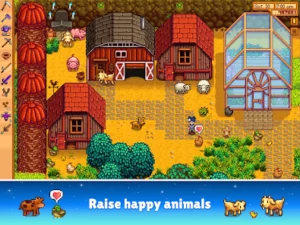Stardew Valley is a beloved farming simulation game that allows players to escape the hustle and bustle of everyday life by immersing themselves in the peaceful world of agriculture. Whether you’re new to the game or a seasoned player, maximizing your farm’s potential can be an exciting challenge. This ultimate guide will explore strategies and tips to help you transform your humble plot into a thriving agricultural empire.
Download Now
1. Plan Your Layout:
Before diving headfirst into planting crops and raising livestock, take some time to plan out your farm’s layout strategically. Consider factors such as crop rotation, accessibility for watering and harvesting, space allocation for buildings like barns or coops, pathways for easy navigation, etc. A well-designed layout not only enhances efficiency but also adds aesthetic appeal.
2. Optimize Crop Selection:
Choosing which crops to grow on your farm requires careful consideration based on seasonality and profitability. Different crops have varying growth times and profit margins; balancing short-term gains (quick-growing cash crops) and long-term investments (high-value artisan goods) is essential. Keep track of market prices through Pierre’s shop or JojaMart so you can make informed decisions about what sells best each season.
3. Utilize Greenhouses Effectively:
Unlocking the greenhouse early on provides an excellent opportunity for year-round cultivation regardless of seasonal restrictions outside its walls! Focus on growing high-profit crops like ancient fruit or starfruit inside this protected environment while utilizing other areas of your land more flexibly throughout different seasons.
4. Raise Livestock Wisely:
Raising animals is another crucial aspect of maximizing your farm’s potential – they provide valuable resources like milk, eggs, wool/fibre alongside companionship! Start with essential animals such as chickens before gradually expanding into cows, sheep, pigs, or goats, depending on available funds and resources. Ensure adequate space, feeding routines, and regular interaction to keep your animals happy and productive.
5. Invest in Upgrades:
Invest in upgrades to boost productivity or make tasks more efficient as your farm grows. Upgrade tools like the watering can or hoe for more extensive coverage areas; build silos to store animal feed conveniently; construct barns/coops with auto-feeders for reduced maintenance time – these investments pay off by saving valuable energy and increasing overall efficiency.
6. Explore Community Center Bundles:
The Community Center is a central hub where players complete bundles by collecting specific items across various categories (crops, artisan goods, fish). Completing bundles unlocks rewards such as new areas on the map or access to powerful crafting recipes! Prioritize completing these bundles early on as they provide significant benefits that aid farm expansion.
7. Engage in Social Activities:
Don’t forget about building relationships with Stardew Valley’s vibrant community! By befriending villagers through conversations, gifts, quests/events participation – you unlock unique perks like discounts at shops or helpful services from certain characters (e.g., faster minecart travel). Building solid connections also adds depth to the game’s narrative while providing additional opportunities for trade/exchange of rare items.
Conclusion:
Maximizing your farm’s potential in Stardew Valley requires careful planning and strategic decision-making regarding crops/livestock selection, along with investing wisely in upgrades/tools/buildings.
Additionally, engaging with the community centre bundle system and nurturing relationships with villagers enhance the gameplay experience while unlocking numerous benefits. With this ultimate guide, it’s time to embark on an exciting journey towards transforming your virtual farmland into a thriving paradise!
Happy farming!








